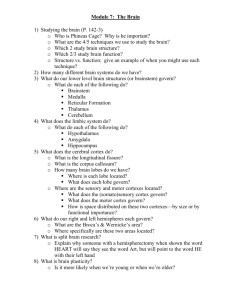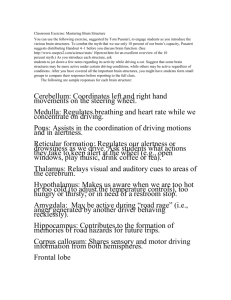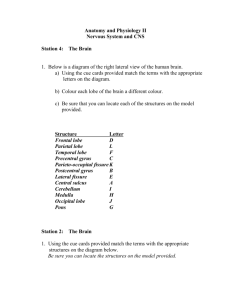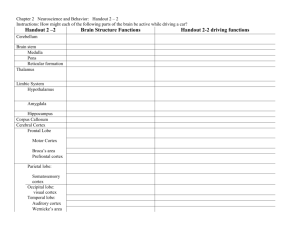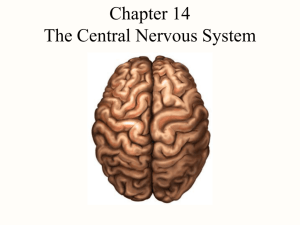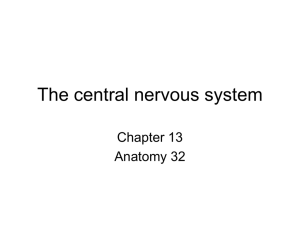Chapter 12 Central Nervous System
advertisement
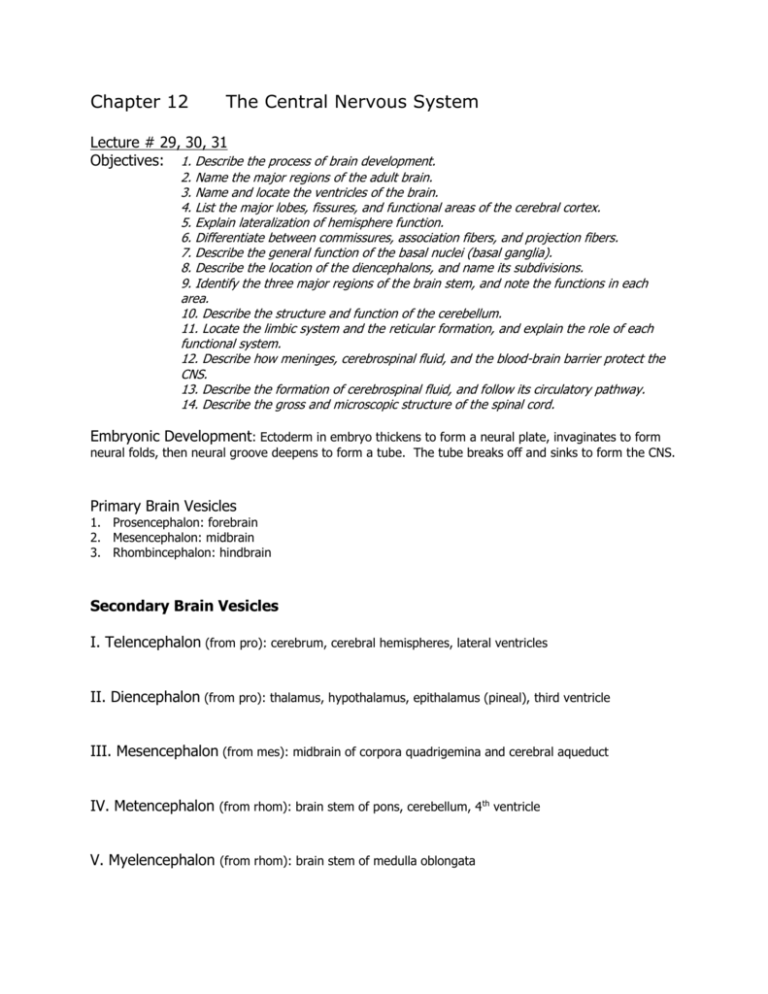
Chapter 12 The Central Nervous System Lecture # 29, 30, 31 Objectives: 1. Describe the process of brain development. 2. Name the major regions of the adult brain. 3. Name and locate the ventricles of the brain. 4. List the major lobes, fissures, and functional areas of the cerebral cortex. 5. Explain lateralization of hemisphere function. 6. Differentiate between commissures, association fibers, and projection fibers. 7. Describe the general function of the basal nuclei (basal ganglia). 8. Describe the location of the diencephalons, and name its subdivisions. 9. Identify the three major regions of the brain stem, and note the functions in each area. 10. Describe the structure and function of the cerebellum. 11. Locate the limbic system and the reticular formation, and explain the role of each functional system. 12. Describe how meninges, cerebrospinal fluid, and the blood-brain barrier protect the CNS. 13. Describe the formation of cerebrospinal fluid, and follow its circulatory pathway. 14. Describe the gross and microscopic structure of the spinal cord. Embryonic Development: Ectoderm in embryo thickens to form a neural plate, invaginates to form neural folds, then neural groove deepens to form a tube. The tube breaks off and sinks to form the CNS. Primary Brain Vesicles 1. Prosencephalon: forebrain 2. Mesencephalon: midbrain 3. Rhombincephalon: hindbrain Secondary Brain Vesicles I. Telencephalon (from pro): cerebrum, cerebral hemispheres, lateral ventricles II. Diencephalon (from pro): thalamus, hypothalamus, epithalamus (pineal), third ventricle III. Mesencephalon (from mes): midbrain of corpora quadrigemina and cerebral aqueduct IV. Metencephalon (from rhom): brain stem of pons, cerebellum, 4th ventricle V. Myelencephalon (from rhom): brain stem of medulla oblongata Ventricles: openings in brain, continuous with one another and the central canal of the spinal cord. Contain ependymal cells and choroid plexuses to produce CSF. They include the lateral (1 st and 2nd ), 3rd cerebral aqueduct, and 4th , and central canal. Cerebral Hemispheres I. Gyri: ridges in the cerebrum. Gray matter on surface, white matter below. Increase surface area for neurons. Precentral gyrus is where voluntary motor recruitment orginates in frontal lobe. Postcentral gyrus is for somatic sensory perception in parietal lobe. II. Sulci: grooves into cerebrum, also for surface area. III. Fissures: deep grooves or sulci that separate lobes of the brain and between the two cerebral hemispheres. Lobes of Brain The cerebral cortex Location of our conscious mind, where all of our awareness, communication, remembering and understanding, and voluntary movements originate. Composed of gray matter, consisting of interneuron cell bodies, dendrites, unmyelinated axons, neuroglia, and blood vessels. Contains three kinds of functional areas: motor areas, sensory areas, and association areas. Each hemisphere is concerned with the sensory and motor functions of the opposite side of the body. Motor areas Found in the posterior part of frontal lobes. Primary motor cortex found on precentral gyrus, see motor homunculis on p. 387; allows us to conscious control precise or skilled voluntary movments. Premotor cortex, just anterior to precentral gyrus, controls learned motor skills of repetitious or patterned nature (playing piano, typing). Also involved in planning movements. Broca’s area on left side near temporal lobe is for the planning and production of speech. Frontal eye field controls the voluntary movement of eyes. Sensory areas Found on postcentral gyrus of parietal lobe. Receives input from somatic (sensory) receptors in body, see sensory homunculis on p. 387. Somatosensory association cortex integrates sensory inputs to produce an understanding of an object being felt Primary visual cortex is on the extreme posterior tip of the occipital lobe. Visual association area, also in occipital lobe, uses past visual experiences to interpret visual stimuli (recognizing objects). Primary auditory cortex in the temporal lobe interprets pitch, rhythm, and loudness. Auditory association areas permits the perception of sound which we hear as speech, wind, music, etc. Wernicke’s area for the understanding of language is also here. Olfactory cortex is in the frontal lobe, just above the eyesocket. Gustatory cortex is deep in the parietal lobe, near the temporal lobe and the somatosensory area for the tongue. Association areas Prefrontal cortex in the anterior portion of the frontal lobe is involved with intellect, complex learning abilities (cognition), recall, and personality. Necessary for abstract ideas, judgment, reasoning, persistence, long-term planning, compassion, following societal rules, conscience. This area is also closely linked to the limbic system (emotional part of brain) and plays a role in intuitive judgments and mood. Wernicke’s area and other language areas (on the left side) are for understanding speech. Lateralization of Cortical Function 90% of people have the left hemisphere exerting greater control over language, math, and logic. The right hemisphere is involved in visual-spatial skills (architecture), intuition, emotion, art, music, poetic, creative and insightful parts of our nature. The corpus callosum allows the two halves to communicate with one another. Cerebral White Matter I. Commissures: Commissures connect corresponding gray areas of the two hemispheres (corpus callosum) A. Corpus Callosum: this commissure can be severed when epilepsy symptoms are so severe that seizures can’t be controlled with medication. This eliminates the connection between the cerebral hemispheres. II. Association Fibers: Association fibers connect different parts of the same hemisphere. III. Projection Fibers: Projection fibers tie the cortex to the rest of the nervous system and to the body’s receptors and effectors. Basal Nuclei: group of nuclei (cell bodies) within white matter of cerebrum; influences muscle movements; regulating attention and cognition; help our ability to perform several activities at once. Dopamine is the neurotransmitter. Huntington’s disease: too much activity or control occurs from this area (autosomal dominant) Parkinson’s disease: too little control from this area due to lack of dopamine. Structures of Diencephalon The thalamus projects fibers to and receives fibers from a specific region of the cerebral cortex. Afferent impulses from all senses and all parts of the body converge on the thalamus. Here the input is sorted out and edited. All other inputs (emotion and visceral input from hypothalamus) also relay through here. It plays a key role in mediating sensation, motor activities, cortical arousal (consciousness), learning, and memory. The hypothalamus is the main visceral control center of the body and necessary for overall body homeostasis. First, it is the ANS control center and it influences blood pressure, rate and force of heartbeat, digestive tract motility, respiratory rate and depth, eye pupil size. Second, it is the heart of the limbic system and the seat for pleasure, fear, rage, sex drive, and other biological rhythms and drives. Third, it regulates body temperature by initiating cooling or shivering. Fourth, it regulates food intake through hunger, and satiety. Fifth, it regulates water balance and thirst. Sixth, it regulates sleep-wake cycles. Seventh, it controls endocrine system functioning. The epithalamus and its accompanying pineal body helps regulate the sleep-wake cycle through the secretion of melatonin. Midbrain Contains many fiber tracts Corpora quadrigemina are the visual reflex center (superior colliculi) and part of auditory relay (inferior colliculi). Substantia nigra is involved in the production of dopamine Pons Consists of relays between the cerebral motor cortex and the cerebellum. Also helps maintain the normal rhythm of breathing. Medulla Oblongata Found under pons, site of origin of the 10th cranial nerve (vagus) so signals to viscera come through here. The medulla oblongata is responsible for regulation of respiration, heart rate, blood pressure It is the reflex center for sneezing, coughing, hiccupping, vomiting, and yawning. Limbic system our emotional or affective (feelings) brain. Recognizes fear, danger, elicits fear response. Allows us to express emotions through gestures. Smells trigger feelings in limbic system. Reticular formation extends through most of under portion of brain (all but cerebrum) to govern arousal. Sends relays through the thalamus to cerebral cortex to keep us alert. Reticular activating system filters floods of sensory input. Injury to this area can cause unconsciousness and coma. Cerebellum: provides precise timing and appropriate patterns of skeletal muscle contraction; smooth, coordinated movement and agility; activity is on a subconscious level. Meninges: three connective tissue membranes to cover and protect the CNS, protect blood vessels, and hold in CSF. These become inflamed in viral and bacterial meningitis. Dura mater: leathery, “tough mother” Arachnoid mater: subarachnoid space is filled w/ CSF and is formed from weblike extensions to pia mater. Pia mater: sticks to brain, “gentle mother” Cerebrospinal Fluid: a liquid cushion that gives buoyancy to CNS. Protects from blows and trauma, nourishes brain, carries chemical signals. Produced by choroid plexus in each ventricle. Blood Brain Barrier: keeps out metabolic wastes, proteins, certain toxins, and most drugs. It is ineffective against alcohol, nicotine, anesthetics, fats, oxygen, carbon dioxide, and fat soluble molecules. Structure of Spinal Cord: major reflex center of CNS. Surrounded by epidural space between bony vertebrae and meninges. Spinal cord ends at L1 and becomes a collection of nerve roots called the cauda equina. There are 31 pairs of spinal nerves that exit through the intervertebral foramina. Gray matter is inside and white matter is on the outside. Contains ascending and descending pathways. Contains a central canal lined with ependymal cells for circulation of CSF.




